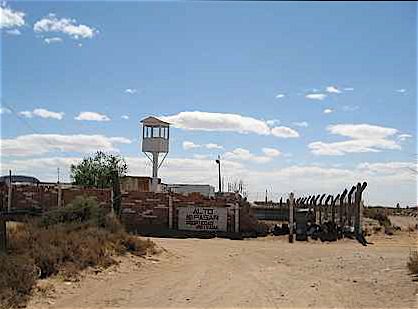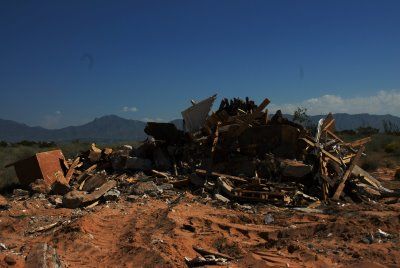
Publisher:
Bonnie King
CONTACT:
Newsroom@Salem-news.com
Advertising:
Adsales@Salem-news.com

~Truth~
~Justice~
~Peace~
TJP
Apr-27-2012 13:25

 TweetFollow @OregonNews
TweetFollow @OregonNews
Last Stand in Lomas de Poleo
Kent Patterson for Salem-News.comIn 2005, one resident, Luis Guerrero, was beaten to death by a group of 20-30 men. In another incident, two young children burned to death in a blaze of mysterious origin...
 Lomas de Poleo Photo courtesy: La Jornada |
(LAS CRUCES, NM) - Descending down the long road that curves down from the heights of Lomas de Poleo, a panoramic view of the borderland dazzles the eyes. Below the now-paved Anapra highway sits the town of Sunland Park, New Mexico, with its big border landfill, racetrack and casino, El Paso Electric plant and scandal-ridden politics. In the background, barren but striking mountains rise up in a hot April sky that begs for action from the rain gods.
If a new border crossing proposed for Anapra-Sunland Park ever materializes, the dusty landscape of Lomas de Poleo will likely transform into a ritzy patchwork of new businesses, frenzied real estate transactions and magnificent views from trendy subdivisions.
Jose Antonio Espino, 48, has lived in Lomas de Poleo for four decades. His father was among the settlers who arrived around 1970. Erecting their homes on the outskirts of an industrializing Ciudad Juarez, Lomas de Poleo’s settlers recreated the world of the small but vanishing Mexican ranch. The new inhabitants planted fruit trees, raised chickens and eggs and tended small herds of cattle, sheep and other animals. Then in 2003, their world changed forever.
That was the year when Pedro Zaragoza Fuentes, scion of a prominent Ciudad Juarez business family, fenced off a section of Lomas de Poleo he claimed was his own. A land battle ensued, eventually garnering international attention.
First making a splash in the dairy industry, the Zaragozas have since branched out to the sporting/entertainment industry and running 80 gasoline stations in Ciudad Juarez. The Pedro Zaragoza Vizcarra Foundation increasingly practices high-profile philantrophy, recently funding a breakfast program for needy children while assisting “the most vulnerable families,” including some currently residing in the section of Lomas de Poleo outside the zone in dispute.
 |
At one time, 250 families or more inhabited the disputed upper mesa of Lomas de Poleo, but after years of sometimes violent conflict only eight families remain on the land, according to residents.
“We haven’t surrendered. This is our land. It’s for our children, but we can’t fight the government and we have to find a way to economically support the people who fight for justice,” Espino told FNS. “The majority of the people left because they were afraid.”
On a recent day, Espino and other residents sketched out a war of attrition that was unleashed against the land resisters. They blamed Zaragoza and his men for electricity cut-offs, bulldozed homes, fires, poisoned dogs and other forms of intimidation designed to force them off the land.
In 2005, one resident, Luis Guerrero, was beaten to death by a group of 20-30 men. In another incident, two young children burned to death in a blaze of mysterious origin. Most recently, the bodies of two young men not from the locality were dumped on land presumably monitored by Zaragoza’s security detail, according to one resident.
Former resident Alfredo Pinon Valenzuela witnessed the fire that claimed the lives of the children but said he was unable to help them escape in time. The 76-year-old man also recalled the day in 2008 when Mexican soldiers arrived to his home and began searching for drugs and weapons. Pinon said the soldiers took his cell phone and .22 caliber rifle, even though Article 10 of the Mexican Constitution permits citizens to have non-military grade guns in their home for personal defense.
 Bulldozed remains of Estella home BorderExplorer.org |
The soldiers then turned the elderly man over to federal police officers, who unceremoniously dumped him off without shoes in the desert outside of Ciudad Juarez, according to Pinon.
As he was being threatened with execution, Pinon said he told the officers to go right ahead and do it. “You have a lot of balls,” Pinon recalled an officer saying. Indignant at his treatment, Pinon filed a human rights complaint with the state agency responsible for investigating violations. But on the very day and at the very time he was ratifying the complaint in Ciudad Juarez, neighbors observed Zaragoza’s men arriving to Pinon’s Lomas de Poleo home, where they began hauling off his furniture before demolishing the residence, Pinon charged. He then outlined how he lost everything- rabbits, chickens, pigs and sheep.
“It was a small farm with a few fruit trees,” Pinon lamented. “I struggled a lot so it would grow because water is scarce.”
Pinon’s property had been appraised as worth about $22,000. The one-time small rancher said he once dismissed a purchase offer by a Zaragoza lawyer for $2,000 as a “joke.” Standing near his old home this month, Pinon summed up bitter sentiments. “I have a lot of anger,” Pinon quipped, admitting he once considered shooting his persecutors but that as a Catholic he could not bring himself to killing. “But sometimes there are moments…,” Pinon trailed off.
By the middle of the last decade, the simmering conflict in Lomas de Poleo had become an international issue. Father Bill Morton, a Catholic priest who lived in Ciudad Juarez before he was ordered expelled from Mexico by the National Migration Institute in 2006 over the Lomas de Poleo battle, mobilized foreign solidarity with the land resisters.
Morton and his allies turned their attention to New Mexico Governor Bill Richardson, who was promoting the development of the nearby San Jeronimo-Santa Teresa border crossing in concert with the New Mexico-Chihuahua Commission, a binational organization established by Richardson and Patricio Martinez, the former Chihuahua governor who is now running for the Mexican Senate in this year’s elections. Pedro Zaragoza was one of the first members named to the commission.
Morton remembered a “call-in” day in 2005, when “thousands of people” in the Columban Order network from across the globe jammed Richardson’s phone lines in support of Lomas de Poleo’s resisters.
In early 2008, an international delegation made up of Amnesty International, La Raza Centro Legal, the International Civil Commission for the Observation of Human Rights and other advocates arrived to investigate and document residents’ complaints against Zaragoza and the Mexican government they accused of supporting and protecting him.
Four years ago, the Lomas de Poleo issue likewise attracted the attention of New Mexico Senator Jeff Bingaman and the Dona Ana County Commission, which heard testimony from Lomas de Poleo residents as well a lawyer for Pedro Zaragoza, who insisted to commissioners that the wealthy Mexican businessman had the rightful title to the land, and that the nature of the conflict was not as “serious” as was being reported.
The commissioners approved a resolution conditioning future border development on respect for human rights and a just resolution of the Lomas de Poleo land dispute.
Father Bill Morton assessed the resistance of the remaining residents as “pretty amazing” considering the time and tribulations that have passed. He credited outside support for staving off a worse situation. “We feel like we’ve been able to diminish the violence,” Morton said. “The more light that was publicly shone on it, the more behaved (Zaragoza and the government) became.”
After 2008, other events overshadowed the drama in Lomas de Poleo. The eruption of the so-called drug war in the heart of Ciudad Juarez now dominated the headlines, and the conflict on the mesa faded to the background. Litigation related to the dispute bogged down in the Mexican legal system.
And little by little, development occurred on the mesa top. Many former settlers’ homes disappeared, and a new technical high school dedicated to training personnel for the maquiladora industry opened up inside the land fenced off by Zaragoza. A nicely-paved road wound by the few remaining houses and corrals in upper Lomas de Poleo and headed to the new, giant Foxconn factory just up the highway.
For years, the local children attended a small elementary school near their homes. But last year, citing dwindling enrollment, Chihuahua state educational authorities decided against renewing a teacher’s assignment to the school. Parents and children staged a lengthy demonstration at state educational offices for a new teacher, but to no avail.
Nowadays, sixth-grader Karen Angela Ramos and a handful of neighboring children attend another, distant school that opened its doors as an act of solidarity. The young girl said she enjoyed her new school, but still experienced a loss. “I felt sad, because I had been there since kindergarten,” Ramos said.
As economic pressures mount, Lomas de Poleo’s hold-outs have banded together in a last-ditch effort to maintain a financial base for their struggle or, in the worst case scenario, at least scrape up the resources necessary to relocate if circumstances dictate.
Recently, residents and a small group of their supporters kicked off the Lomas de Poleo Cooperative. The guests were treated to a meal of homemade, oven-baked Italian pizza served up fresh. Coop member Lucila Carrillo said the new business is initially searching for both local and U.S. markets to distribute its pizzas and hot, bottled salsa. Other product lines, Carrillo said, are on the drawing board.
“We’re forming a cooperative so we can get ahead and pay expenses, because sometimes we don’t work since we have to be here taking care of a home or a piece of property,” Carrillo said.
After years of confrontations, court battles and international campaigns, some residents are determined to stick it out and fight Pedro Zaragoza’s claim. Juan Ramos said it was “unfair” that he had to lose his family’s patrimony because of the power of a millionaire. “The situation is very difficult,” Ramos said. “I don’t know how far (Zaragoza) will go against us, but here we are.”
-Kent Paterson
Frontera NorteSur: on-line, U.S.-Mexico border news
Center for Latin American
and Border Studies
New Mexico State University
Las Cruces, New Mexico
 |
 |
 |
 |
 |
 |
 |
Articles for April 26, 2012 | Articles for April 27, 2012 | Articles for April 28, 2012



Salem-News.com:
googlec507860f6901db00.html

Terms of Service | Privacy Policy
All comments and messages are approved by people and self promotional links or unacceptable comments are denied.
[Return to Top]
©2025 Salem-News.com. All opinions expressed in this article are those of the author and do not necessarily reflect those of Salem-News.com.